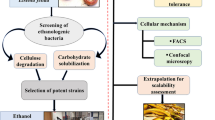Abstract
In this work, the effect of adaptation on P. stipitis fermentation using acid-pretreated corn stover hydrolyzates without detoxification was examined. Two different types of adaptation were employed, liquid hydrolyzate and solid state agar adaptation. Fermentation of 12.5% total solids undetoxified acid-pretreated corn stover was performed in shake flasks at different rotation speeds. At low rotation speed (100 rpm), both liquid hydrolyzate and solid agar adaptation highly improved the sugar consumption rate as well as ethanol production rate compared to the wild-type strains. The fermentation rate was higher for solid agar-adapted strains compared to liquid hydrolyzate-adapted strains. At a higher rotation speed (150 rpm), there was a faster sugar consumption and ethanol production for both the liquid-adapted and the wild-type strains. However, improvements in the fermentation rate between the liquid-adapted and wild strains were less pronounced at the high rotation speed.



Similar content being viewed by others
References
Palmqvist, E., & Hahn-Hägerdal, B. (2000). Bioresource Technology, 74, 17–24.
Persson, P., Andersson, J., Gorton, L., Larsson, S., Nilvebrant, N. O., & Jonsson, L. J. (2002). Journal of Agricultural and Food Chemistry, 50, 5318–5325.
Van Zyl, C., Prior, B. A., & du Preez, J. C. (1988). Applied Biochemistry and Biotechnology, 17, 357–369.
Clark, T. A., & Mackie, K. L. (1984). Journal of Chemical Technology and Biotechnology, 34B, 101–110.
Tran, A. V., & Chambers, R. P. (1986). Enzyme and Microbial Technology, 8, 439–444.
Chandrakant, P., & Bisaria, V. S. (1998). Critical Reviews In Biotechnology, 18, 295–331.
Hahn-Hagerdal, B., Karhumaa, K., Fonseca, C., Spencer-Martins, I., & Gorwa-Grauslund, M. F. (2007). Applied Microbiology and Biotechnology, 74, 937–953.
Lee, J. (1997). Journal of Biotechnology, 56, 1–24.
Amartey, S., & Jeffries, T. (1996). World Journal of Microbiology & Biotechnology, 12, 281–283.
Delgenes, J. P., Moletta, R., & Navarro, J. M. (1996). Enzyme and Microbial Technology, 19, 220–225.
Fenske, J. J., Hashimoto, A., & Penner, M. H. (1998). Applied Biochemistry and Biotechnology, 73, 145–157.
Agbogbo, F. K., Coward-Kelly, G., Torry-Smith, M., & Wenger, K. S. (2006). Process Biochemistry, 41, 2333–2336.
Laplace, J. M., Delgenes, J. P., Moletta, R., & Navarro, J. M. (1991). Applied Microbiology and Biotechnology, 36, 158–162.
Roberto, I. C., Demancilha, I. M., Felipe, M. G. A., Silva, S. S., & Sato, S. (1994). Arquivos de Biologia e Tecnologia, 37, 55–63.
Skoog, K., Jeppsson, H., & Hahnhagerdal, B. (1992). Applied Biochemistry and Biotechnology, 34‑5, 369–375.
Amartey, S., & Jeffries, T. (1996). World Journal of Microbiology & Biotechnology, 12, 281–283.
Nigam, J. N. (2001a). Journal of Applied Microbiology, 90, 208–215.
Nigam, J. N. (2001b). Journal of Biotechnology, 87, 17–27.
Schell, D. J., Farmer, J., Newman, M., & McMillan, J. D. (2003). Applied Biochemistry and Biotechnology, 105−108, 69−85.
Agbogbo, F. K., Coward-Kelly, G., Torry-Smith, M., Wenger, K. S., & Jeffries, T. W. (2007). Applied Biochemistry and Biotechnology, 136–140, 653−662.
Acknowledgment
This investigation was funded by the US DOE project managed by Abengoa Bioenergy R&D. The authors thank the sponsors for their support.
Author information
Authors and Affiliations
Corresponding authors
Rights and permissions
About this article
Cite this article
Agbogbo, F.K., Haagensen, F.D., Milam, D. et al. Fermentation of Acid-pretreated Corn Stover to Ethanol Without Detoxification Using Pichia stipitis . Appl Biochem Biotechnol 145, 53–58 (2008). https://doi.org/10.1007/s12010-007-8056-4
Received:
Accepted:
Published:
Issue Date:
DOI: https://doi.org/10.1007/s12010-007-8056-4




